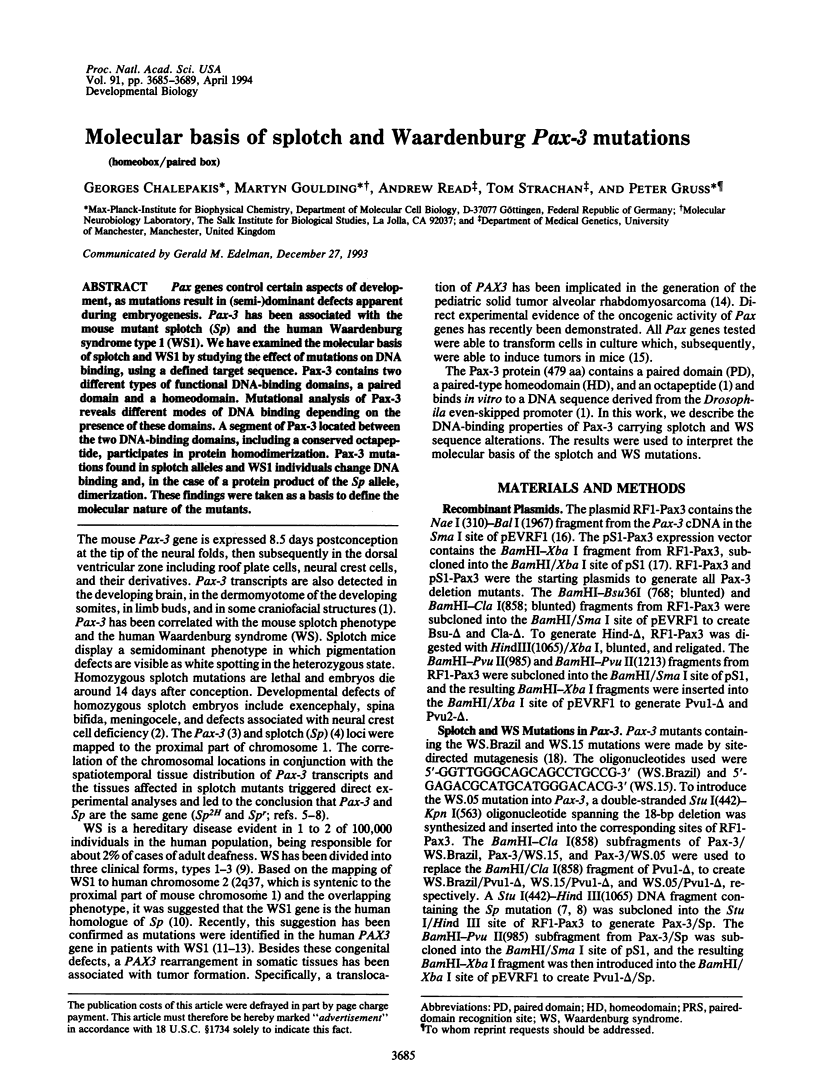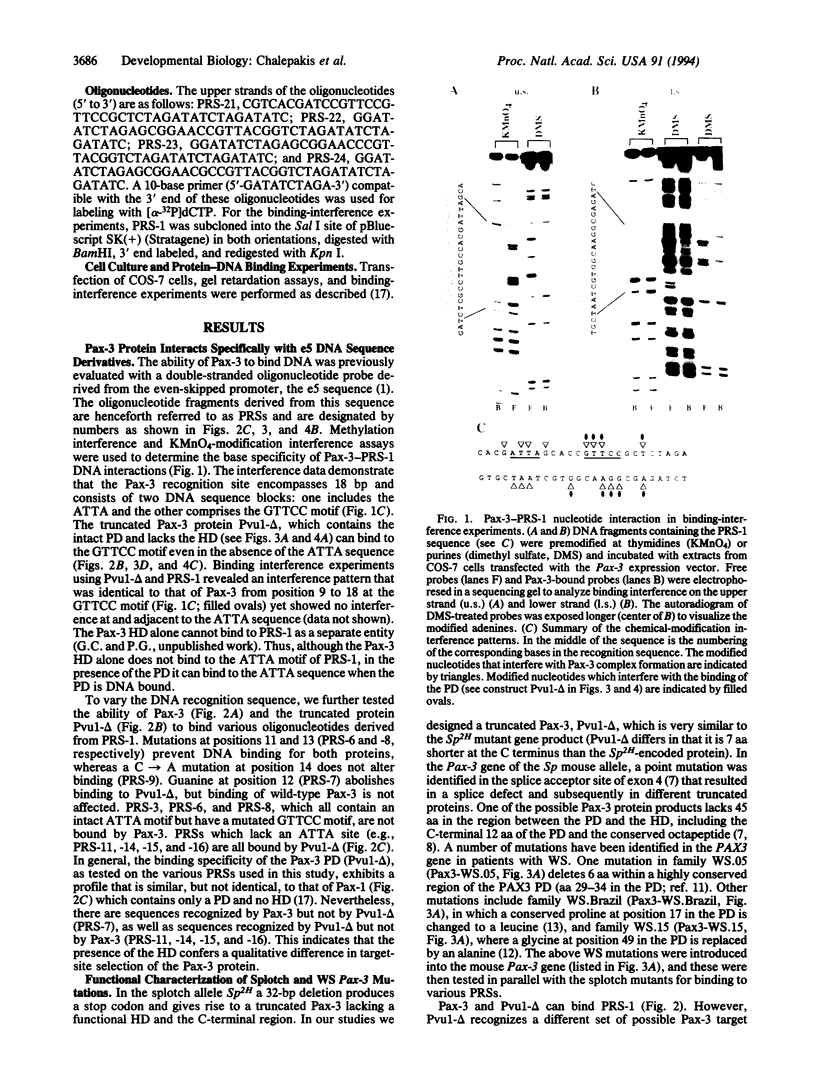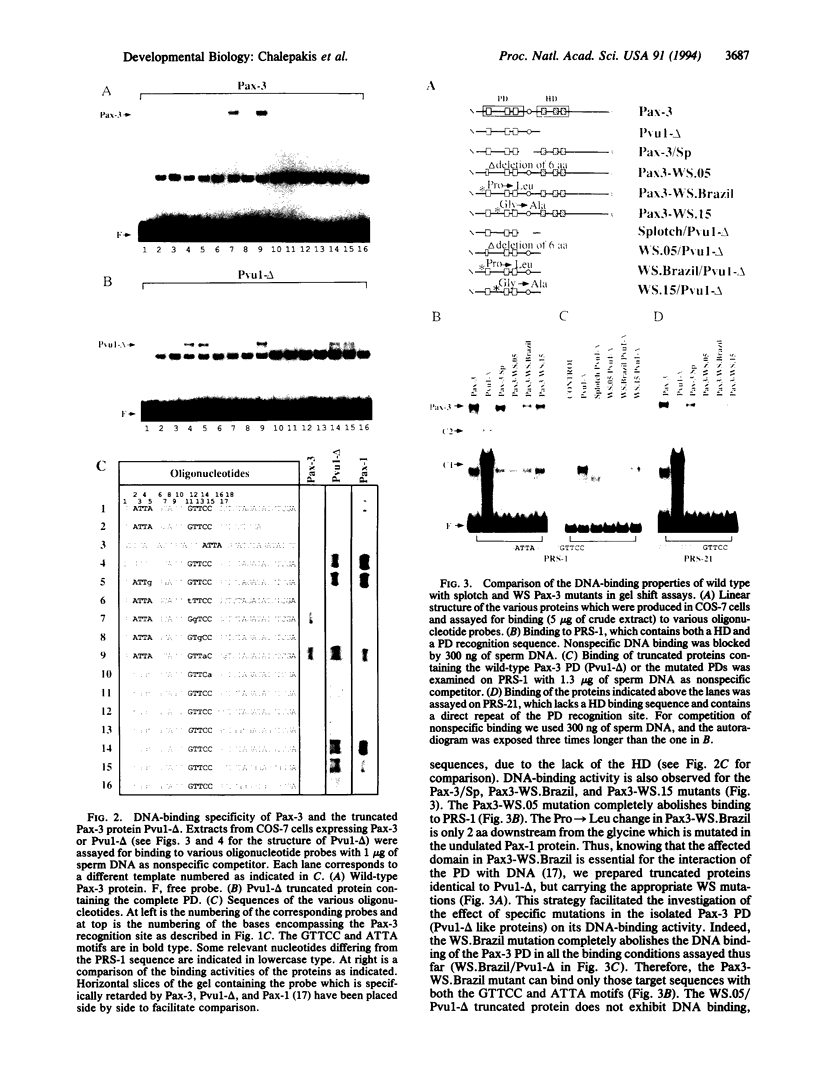Abstract
Pax genes control certain aspects of development, as mutations result in (semi)dominant defects apparent during embryogenesis. Pax-3 has been associated with the mouse mutant splotch (Sp) and the human Waardenburg syndrome type 1 (WS1). We have examined the molecular basis of splotch and WS1 by studying the effect of mutations on DNA binding, using a defined target sequence. Pax-3 contains two different types of functional DNA-binding domains, a paired domain and a homeodomain. Mutational analysis of Pax-3 reveals different modes of DNA binding depending on the presence of these domains. A segment of Pax-3 located between the two DNA-binding domains, including a conserved octapeptide, participates in protein homodimerization. Pax-3 mutations found in splotch alleles and WS1 individuals change DNA binding and, in the case of a protein product of the Sp allele, dimerization. These findings were taken as a basis to define the molecular nature of the mutants.
Full text
PDF




Images in this article
Selected References
These references are in PubMed. This may not be the complete list of references from this article.
- Baldwin C. T., Hoth C. F., Amos J. A., da-Silva E. O., Milunsky A. An exonic mutation in the HuP2 paired domain gene causes Waardenburg's syndrome. Nature. 1992 Feb 13;355(6361):637–638. doi: 10.1038/355637a0. [DOI] [PubMed] [Google Scholar]
- Barr F. G., Galili N., Holick J., Biegel J. A., Rovera G., Emanuel B. S. Rearrangement of the PAX3 paired box gene in the paediatric solid tumour alveolar rhabdomyosarcoma. Nat Genet. 1993 Feb;3(2):113–117. doi: 10.1038/ng0293-113. [DOI] [PubMed] [Google Scholar]
- Chalepakis G., Fritsch R., Fickenscher H., Deutsch U., Goulding M., Gruss P. The molecular basis of the undulated/Pax-1 mutation. Cell. 1991 Sep 6;66(5):873–884. doi: 10.1016/0092-8674(91)90434-z. [DOI] [PubMed] [Google Scholar]
- Epstein D. J., Malo D., Vekemans M., Gros P. Molecular characterization of a deletion encompassing the splotch mutation on mouse chromosome 1. Genomics. 1991 May;10(1):89–93. doi: 10.1016/0888-7543(91)90488-z. [DOI] [PubMed] [Google Scholar]
- Epstein D. J., Vekemans M., Gros P. Splotch (Sp2H), a mutation affecting development of the mouse neural tube, shows a deletion within the paired homeodomain of Pax-3. Cell. 1991 Nov 15;67(4):767–774. doi: 10.1016/0092-8674(91)90071-6. [DOI] [PubMed] [Google Scholar]
- Epstein D. J., Vogan K. J., Trasler D. G., Gros P. A mutation within intron 3 of the Pax-3 gene produces aberrantly spliced mRNA transcripts in the splotch (Sp) mouse mutant. Proc Natl Acad Sci U S A. 1993 Jan 15;90(2):532–536. doi: 10.1073/pnas.90.2.532. [DOI] [PMC free article] [PubMed] [Google Scholar]
- Foy C., Newton V., Wellesley D., Harris R., Read A. P. Assignment of the locus for Waardenburg syndrome type I to human chromosome 2q37 and possible homology to the Splotch mouse. Am J Hum Genet. 1990 Jun;46(6):1017–1023. [PMC free article] [PubMed] [Google Scholar]
- Goulding M. D., Chalepakis G., Deutsch U., Erselius J. R., Gruss P. Pax-3, a novel murine DNA binding protein expressed during early neurogenesis. EMBO J. 1991 May;10(5):1135–1147. doi: 10.1002/j.1460-2075.1991.tb08054.x. [DOI] [PMC free article] [PubMed] [Google Scholar]
- Goulding M., Sterrer S., Fleming J., Balling R., Nadeau J., Moore K. J., Brown S. D., Steel K. P., Gruss P. Analysis of the Pax-3 gene in the mouse mutant splotch. Genomics. 1993 Aug;17(2):355–363. doi: 10.1006/geno.1993.1332. [DOI] [PubMed] [Google Scholar]
- Matthias P., Müller M. M., Schreiber E., Rusconi S., Schaffner W. Eukaryotic expression vectors for the analysis of mutant proteins. Nucleic Acids Res. 1989 Aug 11;17(15):6418–6418. doi: 10.1093/nar/17.15.6418. [DOI] [PMC free article] [PubMed] [Google Scholar]
- Maulbecker C. C., Gruss P. The oncogenic potential of Pax genes. EMBO J. 1993 Jun;12(6):2361–2367. doi: 10.1002/j.1460-2075.1993.tb05890.x. [DOI] [PMC free article] [PubMed] [Google Scholar]
- Sayers J. R., Schmidt W., Eckstein F. 5'-3' exonucleases in phosphorothioate-based oligonucleotide-directed mutagenesis. Nucleic Acids Res. 1988 Feb 11;16(3):791–802. doi: 10.1093/nar/16.3.791. [DOI] [PMC free article] [PubMed] [Google Scholar]
- Skow L. C., Donner M. E., Huang S. M., Gardner J. M., Taylor B. A., Beamer W. G., Lalley P. A. Mapping of mouse gamma crystallin genes on chromosome 1. Biochem Genet. 1988 Oct;26(9-10):557–570. doi: 10.1007/BF02399601. [DOI] [PubMed] [Google Scholar]
- Tassabehji M., Read A. P., Newton V. E., Harris R., Balling R., Gruss P., Strachan T. Waardenburg's syndrome patients have mutations in the human homologue of the Pax-3 paired box gene. Nature. 1992 Feb 13;355(6361):635–636. doi: 10.1038/355635a0. [DOI] [PubMed] [Google Scholar]
- Tassabehji M., Read A. P., Newton V. E., Patton M., Gruss P., Harris R., Strachan T. Mutations in the PAX3 gene causing Waardenburg syndrome type 1 and type 2. Nat Genet. 1993 Jan;3(1):26–30. doi: 10.1038/ng0193-26. [DOI] [PubMed] [Google Scholar]
- Walther C., Guenet J. L., Simon D., Deutsch U., Jostes B., Goulding M. D., Plachov D., Balling R., Gruss P. Pax: a murine multigene family of paired box-containing genes. Genomics. 1991 Oct;11(2):424–434. doi: 10.1016/0888-7543(91)90151-4. [DOI] [PubMed] [Google Scholar]






